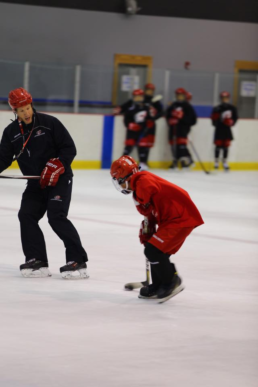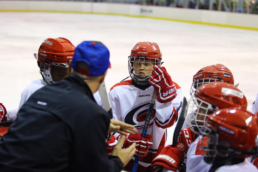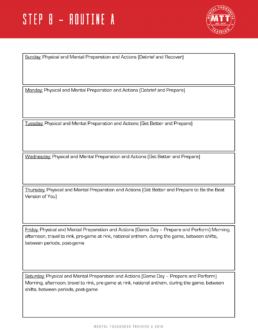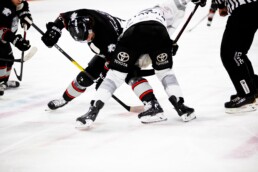Peak Performance: Identity
Peak Performance Identity
Over the years I have worked with many young hockey players who have aspired to make the NHL. Today I am honored to work with players and help them achieve what I couldn’t accomplish through my lack of identity and commitment as a person and player. I too was a young hockey player dreaming of making it to the NHL.
I grew up in a family that valued hard work, perseverance, and integrity. My parents instilled the importance of working hard but never really understood identity and how to separate “who I am ” from “what I do”. This was a lesson I carried with me throughout my hockey career.
As I grew older, and faced many challenges on my NHL journey, I struggled with injuries, setbacks, poor self-image, hate, lack of confidence, and an overall poor identity.
As best I could, I remained committed to my values and my dream. I worked tirelessly to improve my skills, I didn’t seek guidance from coaches or mentors. I lost sight of my broader sense of self.
Honestly, I didn’t like the man I had become. I eventually was emotionally left on the curb in a city I have never lived in or visited. I was lost.
Through the grace of God, I somehow drew strength from a mustard seed of faith. I saw myself not only as a hockey player but as someone who wanted something great from life, I valued success more than I appreciated my next breath of air.
For whatever reason, I found inspiration and guidance in the Bible and mentors who came to my rescue. They invested in me and I reciprocated with the only attribute I knew… effort.
I used my mustard seed of faith as a guide to live a life with purpose and meaning.
Despite the obstacles I faced, I somehow through the grace of God found a commitment to my shaky values, faith, and a dream to become better than my current version of myself. Almost 25 years later, I remain persistent, dedicated, accountable, and diligent in my efforts to improve and succeed.
As best I know how, I remain grounded in my values and faith, and continue to inspire others to pursue their dreams through a healthy identity. Through the grace of God, I am inspired to leave a legacy as a former broken hockey player and as a person who was defined not only by what I did on the ice but by who I am as a child of God.
A Healthy Identity for Peak Performance
Sports can be a powerful metaphor for life, and athletes often learn valuable lessons that can be applied beyond the hockey rink. One such lesson is the importance of separating “who you are” from “what you do.” This concept is essential for developing a healthy identity that can withstand the emotional rollercoaster of the season.
Healthy Identity
A healthy identity is built upon a foundation of core values and beliefs. These values and beliefs help shape a person’s character and guide their actions. Attributes of a healthy identity include:
- Being committed
- Persistent
- Dedicated
- Having integrity
- Being accountable
- Diligent
- Striving for excellence
- Being confident.
When athletes separate “who they are” from “what they do“, they are more likely to embody these attributes.
They are not defined solely by their sport but have a broader sense of self that includes their values, beliefs, and relationships with others.
Faith
For many athletes, their identity is closely tied to their faith. They see themselves not only as athletes but as followers of Jesus Christ.
The Bible speaks to the importance of identity in several passages, including Genesis 1:27, which speaks to the inherent value and dignity of every human being, and in Jeremiah 1:5, which speaks to the idea that each person has a unique purpose and calling.
When athletes see themselves as created in the image of God and set apart for a specific purpose, they can find strength and confidence in their identity. They can use their sport as a way to glorify God and serve others.
Peak Performance
Peak performance requires a mindset that supports flow and clutch states. Flow is a description of feeling and is what many people refer to as being “in the zone.”
Clutch performance describes what performers are actually doing to achieve high levels of performance, such as putting in greater levels of effort and focus and understanding the situational demands and their level of importance. To cultivate a mindset that supports both flow and clutch states, athletes need to focus on mental strategies such as mindfulness, stress management/activation, and outcome goals.
Mindfulness is a state of non-judgmental awareness of the present moment. It addresses all of the factors associated with flow, such as effortless attention, absence of critical/negative thoughts, complete and deliberate focus, heightened awareness, and absorption.
Stress management/activation is the ability to manage your body’s level of energy, which is an essential skill for peak performance. Outcome goals are specific and have a clear outcome in mind, providing a clear target for athletes to aim for.
In conclusion, cultivating a healthy identity requires mental strategies that support both flow and clutch states.
By separating “who you are“ from “what you do“ and focusing on values, beliefs, and relationships, athletes can develop a mindset that supports peak performance.
Mindfulness, stress management/activation, and outcome goals are essential for achieving flow and clutch states and reaching one’s full potential as an athlete and as a person.
Psychological Safety
I know what you are thinking…I thought the same thing, too, when I heard the words psychologically safe environment. Keep reading, it will not be a waste of time…I promise.
Mental toughness is key to success in any field. In order to be successful, we need to be able to withstand the pressure and keep going no matter what. But how do you develop mental toughness? One way is by creating a psychologically safe environment. So as coaches, let’s look at a few things that could help us create a safe space for our players to grow and thrive.
There are 6 attributes that we are going to examine for creating a psychologically safe space, and they are as follows:
- Providing athletes with choices
- Providing rationale for tasks
- Acknowledge our athletes’ feelings (super important)
- Give players the opportunity to do independent work
- Provide non-controlling competence feedback
- Prevent ego-involvement in athletes vs. task involvement
So let's dive right in....What is Team Psychological Safety?
Team psychological safety is defined as a shared belief that the team is safe for interpersonal risk-taking. When players on the team are in a psychologically safe environment, they will play in a power channel. When players play in a power channel, they will be trusting, calm, loose, relaxed, focused, confident, powerful, inspired, and feel challenged and purposeful. When players are not in a psychologically safe environment, they will play in a weak channel. In a week channel, players play heated, tight, tense, overwhelmed, shaky, tired, panicked, rushed, angry, frustrated, worried, anxious, doubting, feel threatened, confused, and overloaded.
Now, let’s examine the attributes of creating a space that is psychologically safe for our team
Providing Athletes With Choices
Giving our players the opportunity to have a choice is essential. We need to remember that our players are individuals with their own set of experiences, values, and beliefs. Consequently, they will have their own way of seeing the game and approaching competition. It is our job as coaches to provide them with the resources and support they need to be successful in their chosen approach.
Providing Rationale for Tasks
When we provide our players with the rationale for the tasks they are being asked to do, it allows them to understand the “why” behind what they are doing. It also allows them to see how their individual role fits into the bigger picture of the team’s success. If we can create an environment where our players feel like they have a real purpose or role on the team, it goes a long way towards creating a psychologically safe environment.
Acknowledge Our Athletes' Feelings
As a coach, you will struggle with this one, but trust me when you incorporate how you feel into skills and drills, something spectacular happens to their performance. The more you isolate but don’t overuse this tactic, the more the player will begin the transition to becoming a world class athlete that loves to practice. Our players should know that, on and off the ice, we have their backs and will stand in any fight for them. When we take the time to listen to our athletes and understand how they are feeling, in turn, it builds a relationship of trust and respect. Sometimes, as coaches, we can be so focused on getting our athletes to perform at their highest level that we forget to acknowledge how they might be feeling and if that could be affecting their performance. Acknowledging and validating an athlete’s feelings are key components of creating a psychologically safe environment.
Give Them Independence
Giving our athletes the independence to make choices allows you as the coach to be their trusted advisor on the journey with them as they fail and succeed. You will create a relationship that will last a lifetime. Creating space for indepence shows that we trust them to be able to work on their own and that we have faith in their abilities. It also allows them to take ownership of their training and performance. This is a key attribute in creating psychological safety because it gives athletes a sense of control and empowerment.
Provide Non-Controlling Competence Feedback
CONTROL YOUR MOUTH…in simplest terms. Empower them for a lifetime, not in the moment, play the long game here. When we provide feedback, it is so important that we do so in a way that does not make the athlete feel controlled. We want our athletes to feel like they are in control of their training and their performance. One way to do this is to provide what is called “non-controlling competence feedback.” This type of feedback is when we give the criticism in a way that does not make the athlete feel like we are making decisions for them. That can easily push players to feel insecure in how they operate in performance. Use “I” statements when providing feedback. For example, instead of saying “You need to work on your mental toughness,” we could say “I noticed that you seemed to get frustrated. How can we fix this and move past it in an effective way?” This approach allows the athlete to take accountability but also feel like we are in this together. Creating an “us” instead of a “them and us” is the objective.
Lastly...Prevent Ego-Involvement in Athletes vs. Task Involvement
In other words, ensure the athlete is focused on the task rather than their self-image. This can look like ensuring your body language is open and that you are engaged with what they are saying. Perhaps avoid crossed arms or looking at your phone while they are speaking. In actuality, it really comes down to showing our players respect. Ego involvement creates an environment where athletes feel like they have to prove themselves, which puts unnecessary pressure on them and a strain on their performance.
Creating a psychologically safe environment and creating the right team only helps to push our players past the limits of what they believe is possible, and that’s a huge win because a lot of our limitations are self-imposed. An important point to keep in mind is that fear helps explain why. Most of our players, out of fear, would rather risk underperforming than ask a question, fearing judgment. So, as coaches, it is our duty to create spaces that groom physical fitness, mental strength, and the readiness to tackle anything that stands against our teams.
Yes, I know. That was A LOT! Take it one step at a time, be patient with yourself and them, it’s a new day of building a trusting environment.
For more on creating a psychologically safe environment, feel free to read the journal article below.
Defining Change
No matter who you are, change is a constant in life. You can’t avoid it, and you can’t run from it. The only thing you can do is learn how to embrace change and master it.
When it comes to identifying change, it takes a lot of courage and honesty with oneself.
Over the course of my journey, I have read and researched many different areas that surround the field of sports psychology. In all of my research conducted, I’ve come to the terms with five simple guidelines for mastering any change in your life. I wish I could take the credit for these five guiding principles but I can’t. These came from Mastery by George Leonard.
Five Guidelines to Mastering Any Change
- Be aware of how homeostasis works
- Be willing to negotiate with your resistance to change
- Develop a support system
- Follow a regular practice
- Dedicate yourself to lifelong learning
Beware of how homeostasis works:
Leonard describes homeostasis as the ability to expect resistance and backlash and that it’s the tendency to resist change in order to maintain a stable, relatively constant internal environment. Homeostasis typically involves negative feedback loops that counteract changes of various properties from their target values, known as set points. So change, by definition, is something that our bodies are wired to resist.
Be willing to negotiate with your resistance to change:
The key here is to become aware of the fact that you have a resistance to change and be willing to negotiate with it. What are you resisting? Why? Is there a way to work with your resistance instead of subjecting yourself to the hiccups they bring? Break change into manageable chunks:The change doesn’t have to be all or nothing. In fact, it’s often easier to make small changes that you can build on over time. Growing up I have always heard the saying “you’ll go nowhere too fast” and this is exactly what we are doing when we rush the process it takes to achieve.
Develop a support system:
When you’re trying to make a change, it’s important to have a supportive network. This could be friends, family, co-workers or even an online community. These people will help you stay accountable and motivated. A lot of time we think we can do everything on our own with no support system, but let’s be honest, every now and then, everyone needs a cheerleader just to hear those “you got this” or “keep pushing” words of encouragement. As much as we don’t like to admit it, we do sometimes seek assurance from others to remind us that our reward is all worth fighting for in the process.
Follow a regular practice:
As we all know and as previously stated, change can be difficult, but if you break it down into small pieces, it becomes more manageable. Change is a learning process and like any skill, the more you practice, the better you become at it. Set realistic goals: change can be daunting and if your goal is too big, you’re likely to get discouraged and give up. so look to set goals that are small and achievable. Change your mindset: this is probably the most important one of all. if you change the way you think about change, it becomes less daunting and more exciting. View it as an opportunity to learn and grow rather than a threat. take baby steps: just like setting realistic goals, taking small steps will help you get through.
And lastly,
Dedicate yourself to lifelong learning:
Change is a never-ending journey. In Mark 9:23 Jesus said “ if you can believe, all things are possible to them that believe. There will always be something new to learn. If you can commit to learning and growing, change will become much easier for you. It’s easy to say you want to learn, but positioning yourself in the environments that will open up those opportunities requires a great level of being teachable. so be teachable in all things!
I hope these five tips help you next time you’re facing change. Remember, it’s not as scary as it seems! Change can be a good thing and an opening for great opportunities. I’m a huge fan of change myself, but that doesn’t mean it’s always easy. Just take it one step at a time, and be patient with the learning process. Change can be scary but if you face it head-on, you’ll come out the other side a better person for having gone through it.
Let’s master change together starting today!
Super Dave
Just Be Grateful…
In our lifetime how many times a day do we think how can I have more. More time, more money, more food, more energy….etc. Very seldom do we take the time to evaluate where we are and what we have in the NOW. It’s hard for us to simply give thanks or show gratitude because the world tells us, there is always more.
Social media seems to condition us for more, under our friends’ guise of happiness and acceptance. We desire to have the things we don’t possess leaving us riddled with dissatisfaction high in debt, doubt and insecurity, and then we ask ourselves why we can never feel full or satisfied. All of these things come down to one thing, and that is simply the fact that we are not truly HAPPY.
But wait…there is a solution!
Positive Psychology suggests that we build from our current strengths not fixating on our bad behavior or focusing on what we need to fix. Positive Psychology suggests we become appreciative and grateful in the now, that’s where we find true happiness. When we are operating from a space of happiness, we are building from our strengths. Building from strengths and fully operating from a lens of positivity, allows us to produce excellence. Taking it a step further, not only do we produce excellence, but we capitalize to our full potential and find ourselves at our peak in the realms of performance.
Positive Psychology and being “grateful in the now” improves our thoroughness, efficiency, and flexibility of complex decision making and influences one’s sense of standards to evaluate your progress against a set of standards. Also, it facilitates the quality and quantity of pathways of thought and seems to boost an aspect of execution function, which is the ability to adjust efficiently to new information and undertake new problem solving efforts in congruence with the new information.
Think about it, when we get a new house, new car or bigger boat we automatically assume we will be happy but the opposite really happens. We tend to forget that wanting more, when we actually get it, means that more is required of us, therefore….that new boat didn’t really seal the deal on happiness because now, there’s just a new problem(s) waiting. This new problem has another level of new responsibility. When we appreciate everything around us and are grateful for what we have we are more creative, relaxed and happy and it is in those moments where the other things we desire but don’t always pursue come as a result.
So what now?
Be grateful in the now, build on your strengths. Learning to be happy starts with being grateful and thankful. Life isn’t always easy, but it is about decisions. Making a decision today to be thankful by controlling your attitude and actions is doable. If you really want to learn more about gratefulness being the key for happiness feel free to check out this article:
https://drive.google.com/file/d/10W7M8ADyTY72i8tiIJ5HcdGIa-tqwWKs/view?usp=sharing
Assessments Are a Part of the Story…Not the Whole Story
Over the years, like you, I have always noticed a decline in some of the players and their performance and skills. We always looked for something new or tried different motivational techniques to cultivate the chemistry and performance habits for them. After a while, we go back to the status quo, because things don’t work or it takes too much effort.
So how do we go from having 2 of your best players all of a sudden taking steps backwards. In fact, we just did some mental toughness training on peaks and valleys in our season, games, and shifts. After studying and reading through my doctoral program, I was introduced to something I don’t think most coaches use as a training tactic or a validated sports psychology assessment(s). More specifically, the ASCI-28 Assessment. The ASCI-28 assessment, better known as the Athletic Coping Skills Inventory-28 assessment, opened my eyes to a whole world of things I never considered when it comes to helping players become the best version of themselves.
The ASCI-28 assessment is designed to differentiate a player’s psychological skills from their physical skills. This idea was a defining moment for me because it drove home the idea that these are two different skill types and they are relatively independent of each other. Sometimes we as coaches are so zoned in the performance piece to our players, that we fail to empathize and take notation of when a decline in performance may result from a bigger mental issue.
Assessments, while they may not always be welcomed, sure teach a lot about the truth of where the players on the team stand. Specific questions I found interesting in the ASCI-28 assessment were ones like:
- On a daily or weekly basis, I set very specific goals for myself that guise what I do
- I get the most out of my talent and skills
- I remain positive and enthusiastic during competitions, no matter how bad things are going
- I worry quite a bit about what others think of my performance
- I feel confident that I will play well
When I read through some of these questions and saw the way some of the team members answered and how they really felt about where they stood on these things, I must admit I was shocked. Though I was shocked, it brought about a sense of empathy I didn’t know my team needed from me.
If you were like me and looking for new opportunities for performance excellence in your coaching then I want to encourage you to take some time to research assessments that can better shape and serve you and your team on AND off the ice. Perhaps the ASCI-28 might help.
This new method added to the team’s structure excites me on many levels and might help swiftly change the negative shift that once hovered over the team.
I think from a big picture perspective what this assessment does for me and perhaps for you is support performance excellence in our roles as sport and performance coaches. This helps me with empathy and understanding each athlete individually. Accounting for unknown considerations when administering measures and assessments allow me to be empathic but also mindful of the situation and circumstance of each player and their physical and psychological status.
For more on ASCI-28, take a look at this sports journal article.
https://drive.google.com/file/d/1nSlS_rb5nDH9i9wrX9sP5d87V_WExZa5/view?usp=sharing
Anxiety and your Plan to Win
Anxiety and your Plan to Win
Doubt, fear, stress and dare I say…. Anxiety are at an ultimate high.
There is no doubt COVID-19 has played a big role in driving these emotions, but is it really COVID-19? Or is it the people around us telling us what we can and can’t do, where we can and can’t go? Everyone is different in how they react to situations, I get that… but I also get it’s also how we react to those emotions that determines if we are allowing these negative emotions to drive unproductive behaviors and allowing them to harm us, or if we are using them as productive behaviors, becoming a master over emotions and allow them to help and promote our ability to succeed.
So this begs the question. In this current culture, how do we play consistently at the upper ranges of our ability under pressure in the biggest moments?
This story is a great example of letting negative emotions control your life and shows how much anxiety, stress and fear can influence you for many years.
“A forty year old man was mauled by a dog when he was young. In the incident, he lost part of his left ear and sustained deep wounds to his arms and chest. As a result, throughout his youth, he naturally avoided dogs.
As a young father, he dreaded the day his children would ask for a dog. Once that day arrived, he decided it was time to go to therapy, but what could be done?
Every time he saw a dog, his heart would pound. He would start to sweat profusely, clutch his chest and feel a sense of doom. This panic was once treated with medication that worked for a time, but excessively sedated him, making it hard for him to function on a day-to-day basis.
The original accident happened when he was only two years old. His age hindered him from being able to logically explain to himself that it was a rare situation. He didn’t have the emotional intellect and as a result, he lived in constant fear of a dog attacking him again.
When he was hurt, the part of his brain responsible for retaining that information made a mental note to equate dogs with emotional, mental and physical pain. If he was able to pinpoint this issue and deal with it when it occurred, he would be far less likely to be anxious at the site of a dog. Instead, the fear festered and continued to grow and influence his life.
One day almost 3 decades later…
His children asked for a dog, the man learned to acknowledge the relevance of his past trauma and how it still influences him today. Ignoring the anxiety, stress and fear only harms the mental state more, weighing it down with illogical ideas and making it nearly impossible to “just deal with it” like this man wanted. He chose to acknowledge his anxiety and fear, and get a game plan so he decided to speak logically to himself before or during interactions with the root of his anxiety (dogs). Over the next several months he worked on increasing his exposure to dogs, to the point where he could disassociate fear with dogs. Learning to be honest about his personal anxiety, stress and fear is the key to overcoming sensitivity to the situation. Once the root issue is identified, work on creating a new association or speaking positivity, rather than negative self talk.

As the world continues to function with the new societal standards from COVID-19, anxiety, stress and fear will continue to rise.
This father didn’t allow his anxiety to control his ability to provide a dog for his children.
As an athlete, success is not found by letting anxiety, stress and fear affect the game. If anxiety is limiting us from reaching the upper ranges of our ability, we’re far less likely to help a team succeed or even find personal success.
However, if we learn to engage our thoughts and energy into positive associations, we can play at the upper ranges of our ability consistently, even under pressure in the biggest moments.
Here are four coping strategies to help you play through your anxiety, stress, and fear:
#1. Be Aware of Your Anxiety
- Don’t be distracted by your anxiety
#2. Be Connected to Your Anxiety
- Speak positivity over it, don’t allow negative self talk
#3. Find Insight into Your Anxiety
- If you recognize where your anxiety is coming from, you can find your purpose
#4. Understand Your Purpose and How Your Anxiety Affects It
- Don’t be in isolation and have a loss of purpose
How To Mentally Prepare For Hockey Tryouts
How To Mentally Prepare For Hockey Tryouts
Tryouts can be a stressful time for many athletes. Players can feel anxious, nervous, and just plain scared. Instead of falling into those emotional traps, you can form a plan to perform consistently and confidently under pressure.
Many athletes ask, “How do I prepare for tryouts?“
The secret to performing your best under pressure is all about your mental toughness! If you don’t have a mental plan, you’ll lose your confidence and get too nervous to play to your potential. So here are seven ways to mentally prepare so you can perform during tryouts.
1. Visualize
Use visualization to prepare yourself mentally before hockey tryouts. Imagine each part of the tryout, and play through the situations in your head. As you visualize the tryout, know what you will do before each drill or play happens. Imagine completing each move in your head perfectly.
Visualization is an underused tool for improving your game because the way we learn is by watching. Once we see something, we picture ourselves doing it, and then we can put it into action. When you visualize how you want to perform, you’re overlearning the skill and programming yourself to play with more confidence.
So when a high-pressure moment arrives, like tryouts, you will know what to do and feel confident.
2. Change Your Perspective
This might sound weird given how much pressure you’re feeling at a tryout, but you want to embrace the pressure and the challenge in front of you!
Instead of viewing the pressure of a tryout as a threat, view it as an opportunity. Research shows that players that see stress as a challenge and opportunity to be the best version of themselves feel excited and perform better. So the moment you don’t feel excited about the opportunity, the pressure becomes an obstacle and makes you tense.
You want to try to enjoy everything about the tryouts! You want to have fun! If you’re having fun, you’ll stay loose and relaxed, which is the only way you will play great hockey. So, while you prep for tryouts, stay away from putting all kinds of pressure on yourself and getting so serious.
3. Make A Plan To Succeed
Success is achieved through preparation and planning. Make sure you have done all you can do both on and off the ice to prepare yourself for tryouts. Create your own mental preparation process for tryouts, practices, and games to move you closer to your dream and mission.
Before hockey tryouts, you can build and write out routines for your mental, emotional, physical, and spiritual capacities. What are you doing in each of those categories to prepare? Set aside time for each category so that you can be prepared for your tryouts. Planning your routine will also eliminate the worries, fears, anxieties, and obstacles that are a part of life and hockey.
4. Park It
On the day of tryouts, you’re going to need to park thoughts and life challenges that could distract you. Using the “park it” method helps you set aside distracting thoughts and focus on what matters most.
Every player should have a specific cue to leave everything else behind and direct their attention to playing. It could be as soon as you step off the bus, you park everything on that bus. Parking those external thoughts will help you dial in and focus on your hockey tryout.
When you’re confronted with a distracting thought, park that thought and revisit it later. By parking your thoughts, you are more focused and attentive to the present.
5. Stay In The Here and Now
You’re focused on something all the time. But are you on a channel that’s productive and helpful? Are you focused on the moment, on the here and now? Or have you drifted to the past or future?
A common mental trap that hockey players fall into during tryouts is to allow their focus to jump ahead to the future and whether they’ll make the team. Your best performance on the ice is when you’re focused on the here and now – you’re trusting yourself. If you’re caught up in the future or past, you’re not trusting yourself on the ice.
Instead, discipline yourself to keep your concentration on what is happening at this moment on the ice. Take it one moment, and one shift at a time! Focus on what you can execute, to keep yourself dialed into the game.
6. Focus on the Process, Not Results.
There are two things you can control, your actions and your attitude. You have the power to control your actions and how you’re seeing the game and believing in yourself.
During tryouts and the hockey season, remember that you can’t control the result of the game. You can do all the actions to the best of your ability, and the other team could be incredible and win anyways. Instead, focus on controlling what is in your power to control.
When you mess up during the tryouts, which is normal, don’t emotionally beat yourself up! Leave the mistake in the past where it belongs and move your focus on to the next play. The time to work on your mistakes is never when you’re under performance pressure and always when you’re relaxed and in practice. Keep in mind that during tryouts, your mistakes aren’t the problem. The problem is how you respond to them. Stay in the now. Leave your mistakes in the past!
7. Remember Hockey Isn’t Your Identity
The identity of who you are is not tied to your performance. When you reference yourself as a hockey player, it’s not who you are. We’re tricking our minds, and when that identity is threatened, it creates fear and anxiety.
Every hockey player on the planet struggles with their confidence at times; it doesn’t matter what level of hockey you are playing. So when you face moments that didn’t work out, know that those moments do not define you or your value.
Over your hockey career, you will have many successes and failures. While both are important to your development as an athlete, your identity is bigger than how you play on the ice.
So keep the tryout in perspective. If it doesn’t go the way you’d hoped, then find out what you did wrong and work on changing it for the next time!
5 Words Every Hockey Player Needs To Hear
5 Words Every Hockey Player Needs To Hear
You gotta want it! Show them you have a little heart.”
“SHOOT!”
“Great job!”
“Better luck next time.”
Those are just a few shouts from the parents watching hockey games around me. I used to be that parent, thinking I was helping by coaching and critiquing during and after games.
When I would say to my son after the game “great job,” what was I really saying?
I started to think about this language, and I started to reflect on what kids want. Well, what would I want? When I was their age, I wanted my parents to tell me they loved me and backed up their words by spending time with me.

As I continue to reflect on “great job,” I realized I had been saying, “I liked how you performed. I liked how you scored or had an assist or hustled.” But what did his coach say about his performance? Was it the same as what I was saying?
As I continued to reflect on the phrase “great job,” I felt even more convicted by the confusion I was creating. I found myself in competition with the coach. I didn’t know the coaches’ feedback or my son’s feedback to the coach. I was in a vacuum, but I said “great job” anyway.
After further thought, I realized my son had his own perspective and thoughts about his game or practice. I didn’t ask about his thoughts, I had no empathy so I just said “great job.” And after all this thinking and processing about the words “great job,” I landed on how complicated and confusing the phrase was to my son. And, more importantly, I was driving a wedge in our relationship.
So what words could I use to bond us together, and wouldn’t compete with his mindshare on performance? After reflecting, I found, “I love watching you play.”
Coaches Bruce E. Brown and Rob Miller conducted a survey where “college athletes were asked what their parents said that made them feel great, amplifying their joy during and after a game. Their overwhelming response: ‘I love watching you play.‘”
“Watching” is the Key Word

Watching is being present and engaged. See the good. See the bad. Just see all of it!
Watching does not mean coaching from the sideline. It does not mean continually critiquing or second-guessing. It means simply being present, engaged, and attentive, so when they ask, “Were you watching when…?” you can say yes!
Many athletes indicated that parental actions and conversations after games made them feel as though their value and worth in their parents’ eyes were tied to their athletic performance and the wins and losses of their team.
Being Present & Praising
When it comes to our kids’ sporting events, I see many parents watching every practice or attending every game. But rarely are parents fully present. They are watching through the lens of a camera. Or the parents are staring at their screen instead of their child.
What a son or daughter needs and what they will remember is their parent’s presence. They need to know you notice them. They need to see an example of what it means to be attentive and present. We set that example with our actions.
More importantly, if we want a strong relationship, our children need to know we have their backs and that we aren’t their critics. And when we are present, we can build trust and encourage players. “I love watching you play” are the sweetest feeling words a parent can say to their child playing any sport.
Taking the time to praise them, and not their performance acts as positive reinforcement. Research shows that people perform best when they get five pieces of positive reinforcement for every one correction or critique.
That is why we must be intentional about the things we do when watching our kids play, especially when we are coaching them. We need to remember that we can simply say, “I love watching you play.”
“I love watching you play,” says, “I don’t care about your performance.”
“I love watching you play,” says, “I don’t care if you messed up.”
“I love watching you play,” tells your child that you value the time we spend together around this sport.
When you say “I love watching you play,” as a parent, you’re actively building trust, which can bond you both to the sport forever.
5 Things Hockey Players Need to Do in the Off-Season
5 Things Hockey Players Need to Do in the Off-Season
As the hockey season comes to a close, it’s time for athletes to start thinking about what they will do in the off-season. The off-season is the ideal time to physically and mentally recover and focus on training to improve your performance for the next season. Here are 5 things you should be doing to make the upcoming season your best yet!
1. Perform a Good, Better, Best Evaluation
The off-season is a great time to evaluate opportunities for improvement. Knowing where you can improve will make you stronger in the new season. What were you good at, and what helped you be good? After you answer that question, use your answers to close the gap between where you are and where you want to be.
Mistakes and setbacks happen. It’s essential to not hold onto shortcomings and instead look ahead to the new season with positivity. Getting advice from coaches and identify areas that could be better, so you are aware of specific changes you need to make.
2. Set Goals

In the off–season, players can keep a personal agenda, planner, or calendar for being accountable. This includes goal–setting. What do players hope to achieve in their off–season? The regular season?
Process goals are based on what you’re going to do. These goals are actions you can control on the ice: moving to the puck, getting to the net. Outcome goals are the outcome, like winning the game. When it comes to mental toughness, it’s better to have process goals. You can’t control the result of the game. You can do all the actions to the best of your ability, and the other team could be incredible and win anyways. With process goals, you focus on controlling what is in your power to control.
Goal-setting helps players stay focused and encourages players to track their progress over extended periods. Players can hang their goals in a visible place, like a fridge door or taped to a mirror.
3. Get Motivated

Read books from successful players, teams, and others who endured hardships. Watch documentaries, videos of amazing plays, and anything else that inspires you. These stories will inspire and motivate you to keep moving towards your vision.
Remember your vision and mission, and keep building the steps you need to take to achieve them. What is your dream? What are you aspiring to become? Your vision answers these questions, it’s inspirational, and it gives you a target to continually work towards.
4. Make A Commitment
Too many hockey players want the result but don’t want to commit to the process. There are no shortcuts to anywhere worth going. This is the battle that many athletes face, and you need to start getting serious and commit to a growth mindset.
Every day you’re going to run into new challenges; this is inevitable. But with a growth mindset, these challenges are new opportunities to grow, learn, and improve.
With a growth mindset, you believe that talent can be developed if you work hard, stick with it, and train. It’s wanting to be the best version of yourself and taking steps to improve continuously.
Every time a challenge is thrown at you this off-season, you will overcome it by simply taking a step to improve. This “one more step” mentality builds your confidence, and it makes the next challenge just a little bit easier to get through. When you commit to this growth and opportunity mindset, you’ll be able to face anything on and off the ice.
5. Relax

This is the time to visit friends and families who were neglected during the regular season. Spend some time creating memories and document those experiences with a camera or journal. Try to avoid anything hockey related for a bit.
Take time for self-care, which can be any activity that you do just because it puts you in a good mental place, like running, or listening to music.
When you step onto the ice at the end of the summer, you will be confident, mentally prepared, and ready to crush your season goals.
Click here to learn more about our mental toughness for hockey training programs and become the best version of yourself.
Use Mental Preparation to Perform More Consistently
How to Use Mental Preparation to Perform More Consistently
Have you ever wondered why one day you play a great game of hockey, but then the next game you start to doubt yourself, lose your confidence or get frustrated because you’re not playing to the best of your ability?
Sometimes you bring your A-game, and other times, it feels like you’ve lost that ability, and you start to second guess yourself. This back and forth can be pretty frustrating because you know you’re not performing your best consistently, but you have no idea why or how to change it.
You’re looking for consistency.
Consistency is what all athletes strive to achieve. But every hockey player will have good days and bad days… It’s inevitable!
If this is true, does that mean we can never be consistent on the ice?
That depends on your definition of consistency. Do you define consistency in terms of effort or results?
If you define consistency in terms of wins or the change in stats, you will be left disappointed. This definition of consistency does not take into account a whole host of factors that are outside your direct control, like:
- Team lineup
- Sickness and injuries
- How many games you played that week
- Playing style of the opposing team
- How your team plays as a unit
What consistency really comes down to is the consistency of mental and physical preparation and consistency of effort.
Without mental preparation, you have little hope of being consistent on the ice.
Mentally Prepare With Routines
Consistency is when you keep things simple and clear and have a routine for being the best version of yourself.
To achieve consistency, you need to redefine consistency in realistic, personal terms. Once you define consistency for yourself, you can identify effective strategies to mentally approach and prepare for competitions and practices.

With this PDF, you can build and write out routines for your mental, emotional, physical, and spiritual capacities. What are you doing in each of those categories to prepare?
Improve Consistency
Consistent mental preparation leads to consistent performance. So, you need to pay particular attention to your mental toughness and preparation plan.
Approach every practice as if it was a game, starting from the time you step into the locker room. Be consistent in your effort and focus for every drill, every skate around, and every scrimmage. Consistent mental preparation leads to consistent performance.
As you build out your routine, think about what will help you mentally prepare for each practice or game.
When is a good time to review videos, talk to your coach, or tape your stick? Will you use imagery while you stretch? What’s the best time to start physically warming up?

When you find a game-day routine, following it helps you feel ready to go mentally and physically. Consistency in your routine will help remove doubt and other obstacles, making your performance more consistent.
Day by Day
When you create your routine for the week, set aside time to revisit your last game and prepare for the next. Some players may close the chapter on the previous game over the weekend, and some may take Monday and Tuesday to do their post-game analysis. Then the rest of the week is focused on preparing and front-loading for the upcoming game.
It’s all about finding a routine that works for you and that you can consistently follow.
If you remain consistent and perform the required actions every day to be the best hockey player you can be, things may not change in the beginning. But if you keep up these everyday actions, one day passes, two days pass, one week passes, six months pass — then by the time you reach these higher numbers, it will be of no surprise to the world that your accumulated actions have created something much bigger for you.

As mentally tough athletes, our performance goal should be consistency and at full speed, even under pressure, no matter the circumstances, and in the most significant moments. If we can prepare properly and approach each situation with confidence and focus, we’ve got a great chance of being successful on a consistent basis.









